Editor's note, added Nov. 15: A launch event for the Center for Staff Life Design was held Nov. 14 on the Homewood campus. Read about it here.
Do you want your work to make more of an impact? Are you looking to increase your salary? Do you need more work-life balance? Are you wondering what your career might look like a decade from now? In the past, you might have wondered if you would have to leave Johns Hopkins to find those answers. Not anymore, thanks to the new Center for Staff Life Design and its inaugural director, Patrick Brugh. His job is to help you design your best life.
Created specifically for the university's 12,000-plus staff members, the Center for Staff Life Design builds on the success of the Life Design Lab, launched in 2018 at Homewood to serve the Krieger and Whiting schools' students and alumni. Unlike the Life Design Lab, the CSLD has no physical location—yet—but that's by design. "We're not asking people to come to us unless that's what they want to do," Brugh says. "We are going to be traveling to the staff and meet them where they are."
CSLD was developed to help in achieving one of the university's ambitious goals in the Ten for One strategic framework: to become a national employer of choice that recognizes, celebrates, and supports its staff and offers multiple pathways to professional and personal advancement for themselves and their families.
"Our vision is that every employee at Johns Hopkins—regardless of their job family, seniority, or their socioeconomic background or social capital—can live their life purpose through, with, or because of the Johns Hopkins community," Brugh says.
Brugh is not new to Hopkins. He was director of operations for the Life Design Lab from 2019 to 2021, left to work as a specialist master in applied design at global management consulting firm Deloitte, and returned to Hopkins in August 2024 to launch CSLD. "I'm really excited to be back," he says.
Brugh has hit the ground running in his new role, talking to as many staff members as possible, diving into their career and personal needs, giving presentations about CSLD, and running pilot workshops. "Our goal was to get in front of 1,000 staff members within the first 90 days, and we're up to 1,231 as of Nov. 1," he reports.
"I talk to people every week who are in a role that they have either outgrown or have hit some kind of a ceiling in their job family, and they don't know where to go next," Brugh says. Most of them love working at Hopkins and want to stay, he says, but they don't know what steps to take to find their next role that will allow them to develop professionally, earn more money, or achieve whatever their desire might be. "Life design is here for that—and the way that we specifically do that is through design thinking activities."
What is life design?
So what does "life design" actually mean? It's an approach to career and professional development that focuses on creating balance and coherency in your life both inside and outside of work, says Brugh, who received his bachelor's degree from the University of Pennsylvania, doctorate from Washington University in St. Louis, and executive certificate in human-centered design and innovation from the Johns Hopkins Carey Business School.
Life design thinking, he says, focuses on three main elements: who you are, what you do, and what you believe. "We want those three things to be in alignment for anybody we work with," he says.
What separates life design from most discussions of work-life balance is its definition of work. In life design, work encompasses all the jobs and tasks a person may do, either paid or unpaid—for their employer, in their community, or at home. Whether we're caring for elderly family members, coaching Little League, or starting a side gig, we are all constantly balancing our responsibilities and passions with our day jobs.
"From a life design standpoint, it's important to recognize all of those things because in order to be the best version of yourself at Hopkins, those other aspects of your life need to be well supported and thought out too," Brugh says. "Our role is to make Hopkins employees feel like they belong and feel like they're living their best possible lives."
While life design focuses on bringing into balance who you are, what you do, and what you believe in your current situation, it also considers other kinds of imbalance—such as when there are skills that you want to be using that you're not. Often, there may be values that are important to you that aren't being entirely fulfilled in your current position.
Another way of thinking about life design, Brugh says, is as "the bridge that connects a person from where they are right now to wherever they want to be in the future."
How will it work at JHU?
The CSLD will enable JHU staff to explore career interests, develop skills and competencies, connect and build networks with peers and colleagues, and navigate JHU's Career Architecture and internal recruitment processes.
Together with a life design consultant, participants will go through the following steps.
Get curious. Start by reflecting on your current situation. Is it fulfilling? Are you using the skills that you value the most? Is it consistent with your values? Is it contributing to helping you be your best self, inside and outside of Hopkins?
Imagine possibilities. This is the ideation phase. Brainstorm as many ideas as possible for what your options may be to make more money, for example—switch careers, get an additional certification, start a side gig. Then select the ones that are most appropriate to your situation.
Experience more. You do this by talking to people who are doing things you might want to do to find out more about their day-to-day experience. It's the best way to test an idea out, to create a prototype for life. Hopkins' huge network makes it easy to find the right people.
Craft your story. Articulating your values, talking about what energizes you, and explaining where you want to go is important in every situation. Whether you're looking to grow in a current role or move into a new industry or organization, you need to be able to tell your story in a compelling way.
Once you've thought those through, you'll find workshops that support your needs. CSLD uses its own Hopkins-specific curriculum, which was developed from the original Stanford Life Design curriculum. The center currently offers in-person and virtual workshops led by a life design expert, with new offerings launching soon. Any employee at JHU can request a workshop.
"Our foundational offering is [group] classroom workshops," Brugh says, and they're offered in lieu of individual coaching for a reason.
"Life design is best done with other folks who are having similar kinds of conversations. In design thinking, we call it radical collaboration," Brugh says. "That means pulling in as many different perspectives as you can." The group format, he says, also leverages Hopkins' huge network and the knowledge and experiences of other employees throughout the institution.
There are currently five workshops on such topics as reframing limiting beliefs that keep us from living our best lives and creating micro-goals and new habits to achieve them. Learning engineer Kelly Cooney is creating a self-paced online version of the workshops that will be available through myLearning. Individual staff or teams can take just one workshop, or the whole curriculum of five.
Learn more here.
Posted in News+Info
Tagged who does that?, advancing your career









